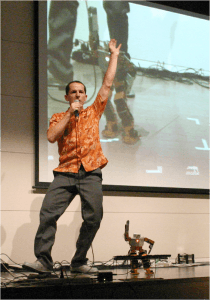Call for Papers
Special Issue of Robotics on “Representations and Reasoning for Robotics”
http://www.mdpi.com/journal/robotics/special_issues/reasoning-robotics
Deadline for manuscript submissions: 28 February 2015
As the field of robotics matures, the development of ever more intelligent robots becomes possible. However, robots deployed in homes, offices and other complex domains are faced with the formidable challenge of representing, revising and reasoning with incomplete domain knowledge about their capabilities, their environments, and how the former interacts with the latter.
Many algorithms have been developed for qualitatively and quantitatively representing and reasoning with knowledge and uncertainty. Unfortunately, research contributions in this area are fragmented, making it difficult for researchers with different expertise to share advances in their respective fields. The objective of this special issue is therefore to promote a deeper understanding of recent breakthroughs and challenges in knowledge representation and reasoning for robots. We are interested in efforts that integrate, or motivate an integration of algorithms for knowledge representation and/or commonsense reasoning, on one or more robots, in different application domains.
Topics of interest include (but are not limited to):
– Knowledge acquisition and representation
– Symbolic and probabilistic representations
– Reasoning with incomplete knowledge
– Interactive and cooperative decision-making
– Learning and symbol grounding
– Qualitative representations and reasoning
We particularly encourage the submission of papers that ground these topics in research areas such as robot perception, human–robot (and multirobot) collaboration, and robot planning.
Guest Editors
Dr. Nicola Bellotto
(University of Lincoln, UK)
Dr. Nick Hawes
(University of Birmingham, UK)
Dr. Mohan Sridharan
(The University of Auckland, New Zealand)
Prof. Daniele Nardi
(“Sapienza” Universita’ di Roma, Italy)
Submission
Submitted manuscripts should not have been published previously, nor be under consideration for publication elsewhere (except conference proceedings papers). All manuscripts are refereed through a peer-review process. A guide for authors and other relevant information for submission of manuscripts is available on the Instructions for Authors page. Robotics is an international peer-reviewed Open Access quarterly journal published by MDPI.

